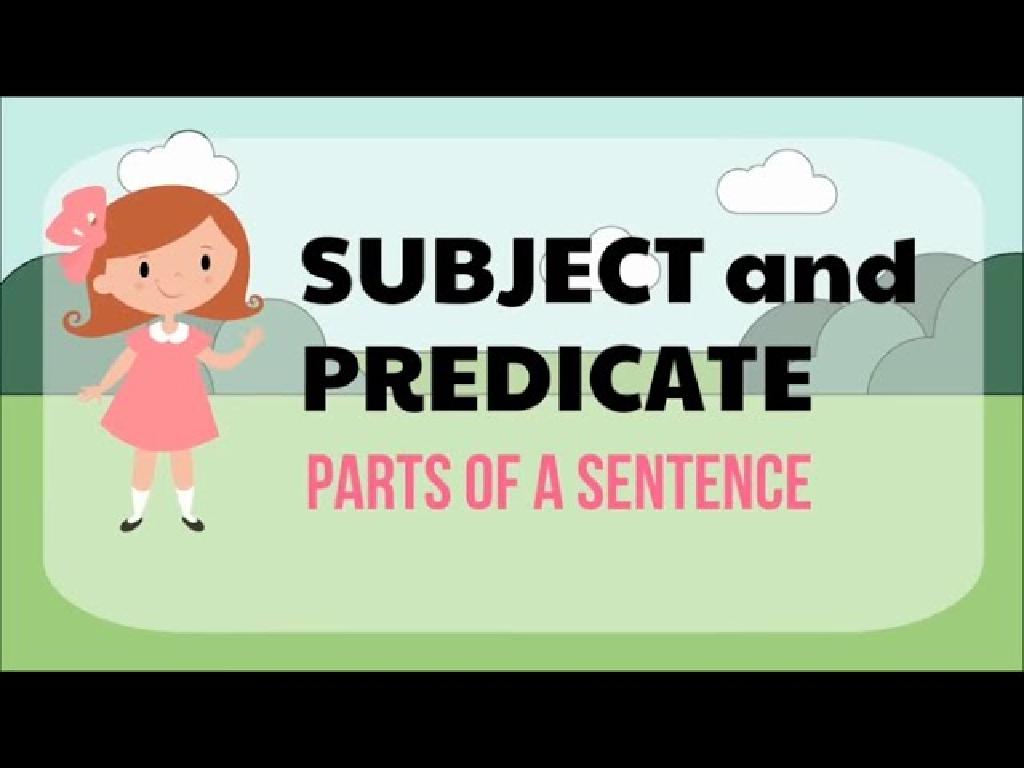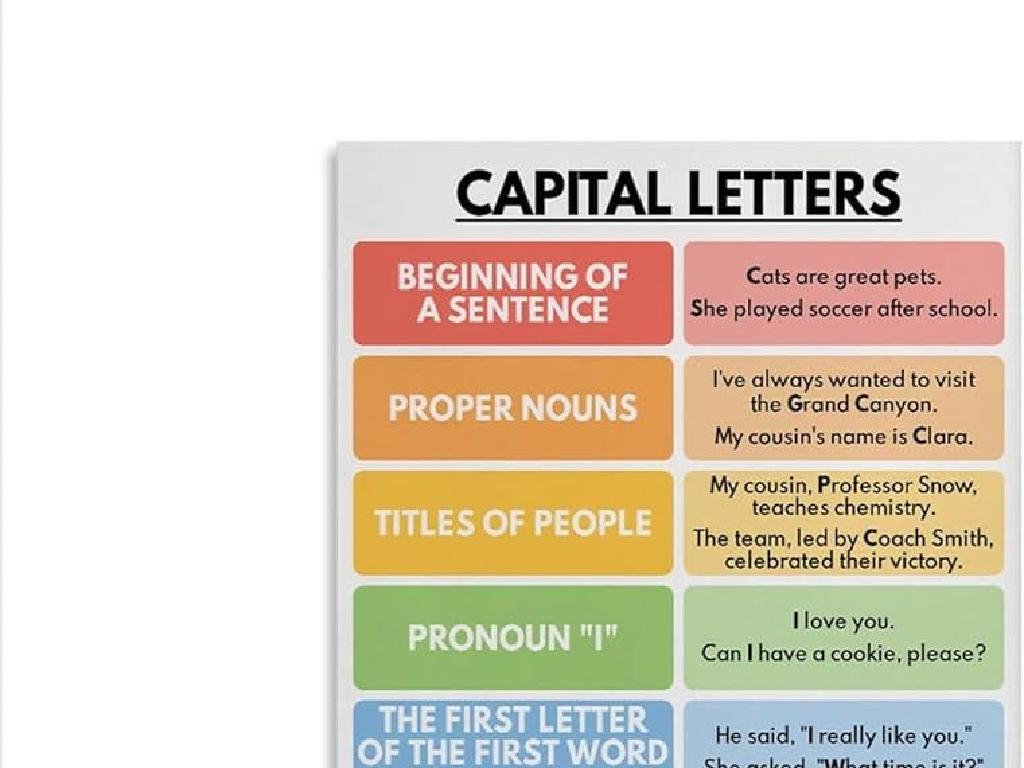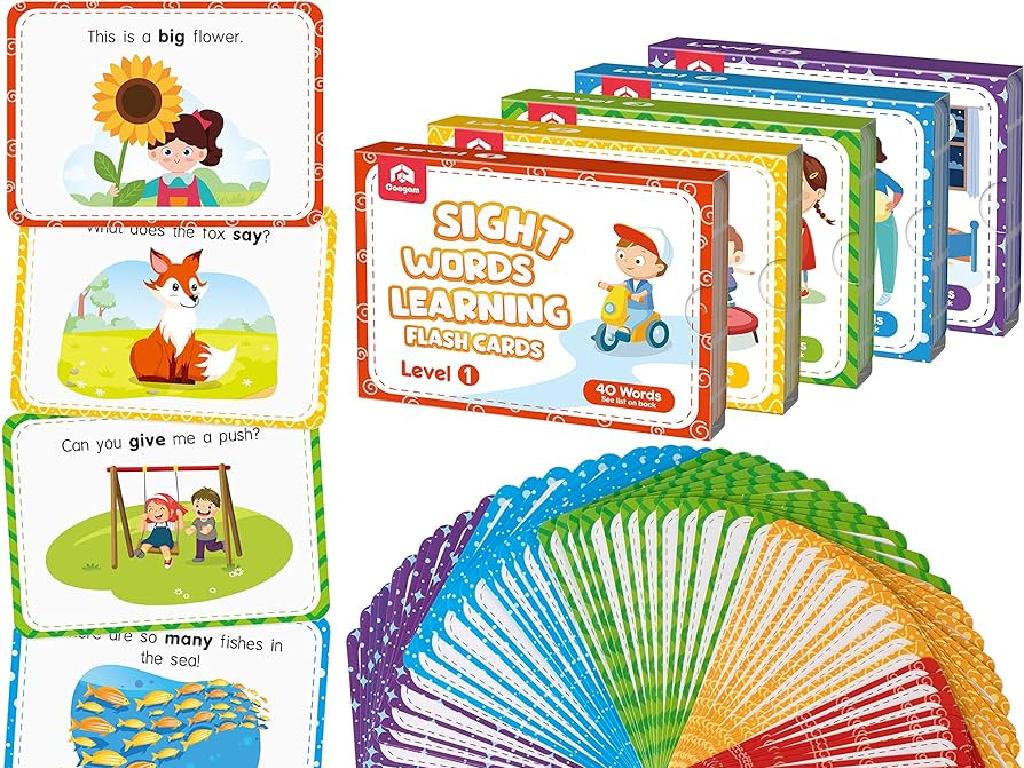Comparing: How Many More Or Fewer?
Subject: Math
Grade: First grade
Topic: Comparing Up To 10
Please LOG IN to download the presentation. Access is available to registered users only.
View More Content
Welcome to Comparing Numbers!
– Learn to compare numbers up to 10
– Understand ‘more’ and ‘fewer’
– ‘More’ means a larger amount, ‘fewer’ means a smaller amount
– Use fun examples for comparison
– Example: 8 apples are more than 5 apples, 3 stars are fewer than 6 stars
– Become a number detective!
|
This slide introduces first graders to the concept of comparing numbers up to 10. It’s important to explain the terms ‘more’ and ‘fewer’ in a way that’s easy to understand. Use relatable and fun examples like apples and stars to illustrate these concepts. Encourage the students to think of ‘more’ as having extra items and ‘fewer’ as having something missing. This will set the foundation for them to become ‘number detectives’ who can spot which group has more or fewer items. During the lesson, engage the students with hands-on activities where they can physically group and compare items to reinforce their understanding.
Learning to Compare: More or Fewer
– What does ‘comparing’ mean?
– Comparing helps us see what is less or more.
– Comparing things in life
– Like toys or fruits, we can see which has more.
– Comparing numbers up to 10
– Using numbers to find bigger or smaller amounts.
– Discovering more and fewer
– Let’s practice finding out which group has more or fewer items!
|
This slide introduces the concept of comparison to first graders by relating it to everyday objects they are familiar with, such as toys and fruits. It’s important to explain that comparing is a way to find out which items are less or more. Use visual aids like pictures of groups of items to illustrate the concept of more and fewer. Encourage the students to participate by asking them to compare things in the classroom. This will help them grasp the concept of comparison before moving on to comparing numbers up to 10. The goal is for students to understand that comparison is not just for objects, but also for numbers, and to be able to identify which of two groups has more or fewer items.
Meet the Number Line Friends
– Number Line Friends introduction
– Each friend represents a number
– Friends 1 to 10 help us learn numbers
– Friends near the start and end
– Who is closer to 1, and who is closer to 10?
– Comparing friends on the line
– See which friend stands more to the right or left
|
This slide introduces the concept of a number line as a visual aid to help first graders understand the idea of comparing quantities. Each ‘Number Line Friend’ represents a different number from 1 to 10. By visualizing these friends on the number line, students can easily compare which numbers are greater or fewer by seeing their positions relative to the start (1) and the end (10) of the line. Encourage the students to think of the number line as a playground where each friend stands at different points. Ask them to identify which friends are near the start (smaller numbers) and which are near the end (larger numbers). This will help them grasp the concept of comparing numbers in a fun and engaging way.
Comparing Apples: More or Fewer?
– Which basket has more apples?
– Count apples to find fewer
– Count each basket’s apples carefully
– ‘More’ equals a bigger number
– More apples means the number is higher
– ‘Fewer’ equals a smaller number
– Fewer apples means the number is lower
|
This slide is aimed at helping first-grade students understand the concept of comparison by using apples in baskets. Start by showing pictures of baskets with different numbers of apples. Ask the students to observe and decide which basket has more apples. Then, guide them to count the apples in each basket to determine which one has fewer. Explain that ‘more’ means there are additional apples compared to another basket, indicating a larger quantity, while ‘fewer’ means there are not as many apples, indicating a smaller quantity. Use real apples or counters if possible to make the activity hands-on. Encourage the students to use the terms ‘more’ and ‘fewer’ in full sentences to describe their observations.
Using Our Hands to Compare Numbers
– Show numbers with fingers
– Compare more or fewer fingers
– If I have 5 fingers up and you have 3, I have more.
– Hands-on number difference
– Seeing and feeling the difference helps us learn.
– Practice with a partner
– Work with a friend to show different numbers.
|
This slide is designed for a hands-on activity where students will use their fingers to visually and physically compare quantities, reinforcing the concept of ‘more’ and ‘fewer’. Encourage the students to pair up and take turns showing different numbers of fingers to each other. Ask them to identify who has more or fewer fingers raised. This activity will help them understand the concept of comparison by using their own hands, making the learning process interactive and tangible. Provide guidance and ensure that each student gets a chance to participate. You can suggest different numbers to compare and encourage students to articulate the comparison in full sentences for better understanding.
How Many More to Make 10?
– Start with a number less than 10
– Count objects to reach 10
– Use blocks or toys to add up to 10
– Play a game with number lines
– Use a number line to jump to 10
– Discover ‘how many more’ needed
– How many jumps to get from 2 to 10?
|
This slide is designed to help first graders understand the concept of ‘how many more to make 10’ by using tangible objects and interactive games. Start by picking any number less than 10, and then use classroom objects like blocks or toys to count up until there are 10. Introduce a number line as a visual aid to help them see the distance from their starting number to 10. Engage the students with a fun game where they use the number line to ‘jump’ to 10, counting each jump as one more. This activity will reinforce their understanding of addition and the concept of ‘how many more’. Encourage students to explain their thought process and how they determined the number of objects or jumps needed to make 10.
Class Activity: Number Detective
– Team up with a partner
– Solve ‘how many more or fewer’
– Use objects to compare two groups
– Share your answers
– Explain your detective work
– Tell the class the steps you took
|
In this engaging class activity, students will pair up to practice comparing quantities. They will use physical objects or illustrations to determine ‘how many more’ or ‘how many fewer’ one group has compared to another. After solving the mystery, each pair will present their findings to the class, explaining the process they used to arrive at their answers. This activity reinforces the concept of comparison and helps develop critical thinking and communication skills. Possible activities include comparing sets of blocks, crayons, or stickers. Encourage students to use terms like ‘more than’, ‘fewer than’, and ‘equal to’ in their explanations.
Conclusion: Becoming Number Detectives!
– Celebrating our number detectives
– Comparing numbers up to 10
– Understanding ‘more’ and ‘fewer’
– ‘More’ is when one group has extra items than another. ‘Fewer’ is when it has less.
– Practice makes perfect
– Keep practicing with toys, snacks, or crayons to become a pro!
|
Well done to all the students for learning how to compare numbers up to 10 today! Reinforce the concept that ‘more’ indicates a larger quantity and ‘fewer’ indicates a smaller quantity. Use everyday examples like comparing sets of blocks or pencils to solidify their understanding. Encourage them to practice at home with items they enjoy, like counting their toys or pieces of fruit, to determine which has more or fewer. This will help them apply what they’ve learned in class to real-world situations and enhance their number sense.






